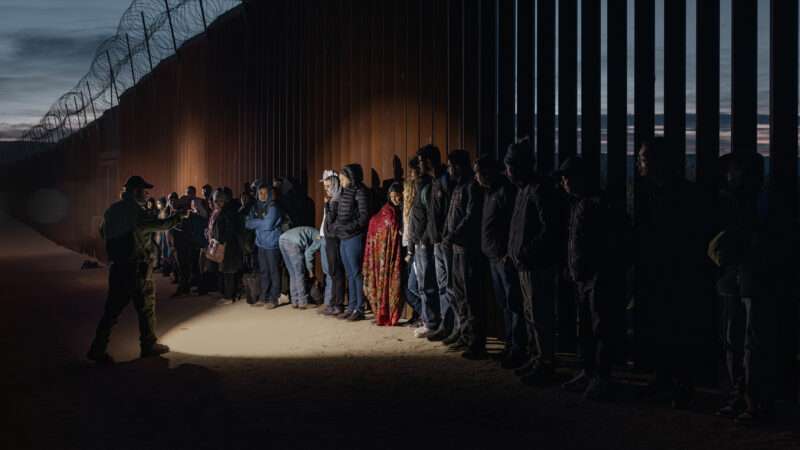Housing news happens all across the country, but this week’s Rent Free is a little more California-centric. Our stories include:
- An L.A. judge stopping Beverly Hills from issuing any building permits (unless they add new housing) until the city comes into compliance with state housing law.
- California Forever releases the language of a ballot initiative legalizing the company’s plans to build a new city in rural Solano County.
- Neighborhood activists in Alexandria, Virginia, are suing to overturn the city’s recently passed zoning reforms.
But first, our lead story about zoning laws once again coming for the Good Samaritan.
Pastor Criminally Charged With Zoning Violations for Sheltering the Homeless
Since March 2023, Chris Avell’s church, Dad’s Place, in Bryan, Ohio, has been keeping its doors open 24/7 for anyone who might stop by to use the church’s kitchen, get food for themselves or their pets from its pantry, or join in church services.
When the homeless shelter next door is full, Dad’s Place will take in some of those people too. Avell considers all these activities a core part of his church’s mission. The city of Bryan, however, considers his sheltering of people an illegal, residential use of a commercially zoned property.
This past New Year’s Eve, when Avell was arriving at the church to preach that Sunday morning, a police officer served him with 18 criminal charges related to violations of the town’s zoning code. Avell pleaded not guilty to those charges earlier this month.
Churches’ charitable activities often don’t fit neatly into zoning codes’ definitions of commercial and residential uses. For that reason, they often get dinged with code violations for doing things like operating a soup kitchen in a residential area or sheltering people in a commercial zone.
The fact that churches are also serving the poor and homeless can make them a target of nuisance complaints from neighbors and extra scrutiny and enforcement from local officials as well.
Bryan’s decision to criminally charge Avell is nevertheless unusually punitive.
“It’s a rarity that a city and a mayor would press criminal charges against a church period. I’m not aware of a mayor anywhere in the country prosecuting a pastor for having his church open. That seems to be the very definition of religious discrimination,” says Jeremey Dys, an attorney with the First Liberty Institute who is representing Avell.
City officials hit Dad’s Place with an escalating series of complaints before it filed criminal charges.
In early November 2023, city police and fire personnel visited Dad’s Place, where they interrogated people inside and recorded a number of alleged violations of the zoning and fire code. They gave the church 10 days to fix the code violations and stop letting people use the church as a residence.
After those ten days had expired, the city’s zoning administrator also visited the church, where he observed more allegedly illegal residential activity including people sleeping in chairs and makeshift bedrooms and preparing food in the church’s kitchen. The administrator’s report recommended charges be filed against Avell.
Dys argues that the city is using an unfairly narrow definition of what counts as church activity to persecute Avell and Dad’s Place.
“It may not look like St. Paul’s cathedral, but it is in every sense a church,” he says. “Mayor [Carrie] Schlade has in her mind that churches meet at 10 a.m. to noon on a Sunday morning and then they lock the doors and go away for the rest of the week.”
The city objects to the idea that they’re discriminating against Dad’s Place.
“Pastor Avell never requested, nor was approval given, to use Dad’s Place as a residence or homeless shelter. The city enforces its zoning code equally against all. A church does not have special rights under the zoning code,” reads a city press release from last week.
A subsequent fire department investigation this month also discovered a gas leak and other fire code violations, says the press release.
Dys says that the church is eager to provide a safe environment but that city officials are unfairly targeting Dad’s place and that they are giving the city shifting demands on what needs to be done to the building. He notes that the pastor of the previous church that had occupied Dad’s Place’s building lived on site.
Attempts to negotiate with the city have gone nowhere, says Dys. “It’s been ‘kick everyone out and then we’ll talk’.”
L.A. Judge Says Beverly Hills Can’t Issue Non-Housing Building Permits Until It Complies with State Housing Law
Beverley Hills, California, property owners are the collateral casualties in a war between the city and activists suing over its failure to allow new housing construction.
Last week, the Los Angeles Times reported that a Los Angeles County Superior Court judge had blocked the city from issuing new building permits for projects that don’t add new housing. That means anyone in Beverly Hills wanting to expand their business or dig a pool in their backyard now can’t.
The order comes in a lawsuit brought by the non-profit Californians for Homeownership against Beverly Hills for adopting what they allege is a housing production plan that doesn’t meet state requirements.
For background, California gives cities targets of how many housing units they should be permitting to keep up with job and population growth. Localities are required to produce “housing elements” outlining where this new housing can go. The state reviews and certifies these housing elements.
One trick cities have long used to perfunctorily comply with the law while avoiding actually having to allow new housing is to identify existing, profitable businesses as the site of future housing. The city can say it’s planned for new housing, even though it’s exceedingly unlikely the business will actually be redeveloped.
State housing officials accused Beverly Hills of doing just this when it submitted a draft housing element for review. When Beverly Hills went ahead and adopted the housing element, Californians for Homeownership sued the city.
Courts have a lot of discretion to craft remedies and block cities’ ability to issue permits if they’re out of step with state housing law, says Chris Elmendorf, a law professor at the University of California, Davis. But they’ve generally used these powers sparingly. A complete moratorium on all building permits, but for those that involve adding new housing, is possibly unprecedented, he tells Reason.
Pro-development “yes in my backyard” (YIMBY) legislators and activists have cheered the ruling.
“Ignoring state housing law has consequences,” said California Sen. Scott Wiener (D–San Francisco) on X (formerly Twitter).
To be sure, the city has invited these consequences by flouting pretty clear warnings from state officials about the inadequacy of its housing element. It’s true too that Beverly Hills’ restrictions on new housing production crush property owners’ ability to improve their land and make the city more unaffordable than it otherwise would be.
Still, the people suffering consequences of Beverly Hills’ NIMBYism and irresponsibility aren’t really the city government but residents who don’t have any direct ability to force their city government to do anything.
Supporters of the courts’ moratorium say an inability to get permits will encourage these residents to pressure their local leaders to get into compliance with state law. That also strikes me as overreach. It’s an attempt to coerce people into supporting local policy changes by taking away their private rights to improve their property.
New Ballot Initiative Would Legalize California’s Newest City
Far away from Southern California’s wealth, growth-hostile enclaves, development company California Forever has released the language of a proposed ballot initiative it’ll need to pass to build a new, urbanist-inspired city in rural Solano County.
The 83-page initiative, which is intended to appear on the November 2024 county ballot, would amend the county’s existing zoning laws and urban growth boundaries to allow a new community on 18,600 acres of land owned by California Forever’s subsidiary company Flannery Associates.
The initiative would require the company to abide by a number of community benefits agreements—including paying $500 million for scholarships, affordable housing, and parks, as well as another $200 million to invest in existing downtown areas in the county’s existing communities.
The California Forever plan for a new city has been controversial since before it was even unveiled. The mysterious Flannery Associates’ land acquisitions led to lawsuits between existing landowners and the company. Congress held hearings on whether the company’s land purchases near Travis Air Force Base was some sort of Chinese spy plot.
The New York Times eventually uncovered that the land purchases were not an act of espionage, but something even more insidious: a tech-billionaire-backed plan to build a whole new city.
The company has done its best to frame its new city plans as something sustainable and desirable, but not necessarily radical. “All cities were once ‘new’ cities,” California Forever says in some of the pitch material on its website.
California Forever’s plans have received a frosty reception from Solano County residents in community meetings thus far. Should it pass, the ballot initiative would also require an exacting level of environmental review to be done of the proposed new community. That could open up the company and the county to years of environmental litigation from project opponents claiming this or that environmental impact wasn’t studied enough.
Another Day, Another Lawsuit Trying to Overturn Zoning Reform
Speaking of excessive litigation, neighborhood activists in Alexandria, Virginia, have filed a lawsuit to undo a suite of zoning reforms the city passed late last year.
The suburban D.C. community’s reforms allowed at least four units on all residential lots, housing in industrial zones, reduced parking minimums near transit, and expanded a density bonus program for affordable housing.
A lawsuit filed by the Coalition for a Livable Alexandria and several individual members, and posted online by WTOP, claims the city failed to show that allowing more housing in the city will improve housing affordability. By not establishing that link, the city had acted in an “arbitrary and capricious” manner, they argue.
The group’s lawsuit also argues that the zoning reforms violate the Virginia Constitution’s equal protection guarantees because they leave private restrictive covenants in place. Anti-development activists managed to block Montana’s zoning reforms using that same argument.
The Livable Alexandria lawsuit also seems to argue there’s an equal protection violation inherent in upzoning single-family neighborhoods because some single-family homeowners are black. The city’s abolition of single-family zoning “deprives Plaintiff Phylius Burks, an African American, of equal protection by moving the goal post as to land ownership after Plaintiff Phylius Burk purchased a single-family home” reads the lawsuit.
We’ll have to wait and see if that argument sticks.
Quick Hits
- Montana housing advocacy group Shelter WF is petitioning to intervene in a lawsuit brought by anti-zoning reform group Montanans Against Irresponsible Densification (MAID) against the state for several housing laws that passed last year. MAID convinced a Gallatin County judge to block two state laws allowing duplexes and accessory dwelling units (ADUs) in single-family neighborhoods. Shelter WF argues that ADUs and duplexes are some of the most accessible forms of housing. “This package of legislation urgently and responsibly addresses the challenges Montanans are facing in seeking homes that are affordable and decent, and Shelter WF looks forward to defending it in court,” said Shelter WF President Nathan Dugan in an emailed press release.
- The Atlantic‘s Jerusalem Demsas covers the civil war raging between pro- and anti-zoning reform environmentalists in Minneapolis, Minnesota. A lawsuit from two environmentalist groups there managed to overturn that city’s first-in-the-nation abolition of single-family zoning.
- Chris Arnade muses at Unherd about how American cities manage to have a lot of laws and a lot of lawless squalor. His diagnosis? We’re a high-regulation, low-trust society that’s banned ordinary people from making nice things.
- Dad’s Place isn’t the only church whose provision of shelter has upset zoning officials. Church of the Rock is suing the city of Castle Rock, Colorado, after it ordered the church to stop letting people sleep in two trailers on church property.
- The Marin County Board of Supervisors did pass new restrictions on short-term rentals—which Rent Free had previously covered—earlier this month. The passed ordinance has a higher cap on short-term rentals than the original proposal, although short-term rental operators are still critical of the measure. The ordinance will now be reviewed by the California Coastal Commission, which must also approve it.
- New Mexico housing activists held a rally in favor of rent control on Saturday in Santa Fe. Lawmakers who support rent control told the local press it’s unlikely they’d be able to pass such a policy during the short, 30-day legislative session. A number of other states are considering rent control bills during their 2024 legislative sessions.
- While the Marin County government cracks down on short-term rentals for allegedly eating up long-term rental housing stock, a local developer is having to fight tooth-and-nail with the wealthy, incorporated Marin town of Belvedere to get approval for a 40-unit development.
Regulation of the Week
The occupancy limits of Fort Collins, Colorado, allow a family to live with an exchange student or a nanny. A family living with an exchange student and a nanny is prohibited. Maybe this is why more sitcoms aren’t set there.
The post Zoning Bans the Good Samaritan appeared first on Reason.com.
from Latest https://ift.tt/jIRDbB8
via IFTTT








